I was anxious to get my hands on Star Trek: The Next Generation Deck Building Game, mainly because I’m a Star Trek fiend. I owned the Star Trek: The Next Generation Customizable Card Game as a kid (review to come eventually) and have recently reviewed Star Trek Fleet Captains and Star Trek Expeditions.
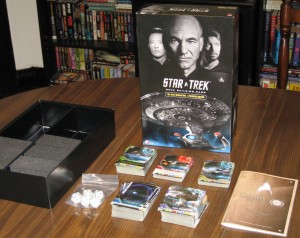
Star Trek: The Next Generation Deck Building Game, 2-5 Players, Ages 13+, Average Play Time = 60-90 Minutes
Compared to anything else in my collection, this particular deck building game plays very similarly to Dominion, though the mechanics are executed a little differently. The game comes with three scenarios, each with their own unique set of event and mission cards. The Exploration Scenario is a free for all to see who can gain 400 mission points first, the Borg Invasion Scenario is a co-op game in which players work together to defeat the Borg, and the Klingon Civil War Scenario is a 2 vs 2 team battle in which one team must satisfy a set of goals before the other in order to prove that they can lead the Klingon Empire.
Components
Dice – There a five, 20-sided dice that serve as hit counters. Hit counters are used for everyone’s flagship (player’s only have one active ship at one time).
Starter Cards – These are the standard cards that all players receive as their initial playing deck.
Basic Character Cards – These “no-names” are crewmen and officers that you pick up along the way to help you overcome challenges and perform actions. They also award XP when played on your turn, allowing you to purchase better cards. There are Ensigns, Lieutenants, and Commanders.
Starbase Cards – This set of cards makes up the largest deck. They are a combination of maneuvers, setups, unique characters, and wormholes. Players will be “purchasing” these cards with XP so that they can be added to their individual playing decks. They will assist players in a variety of ways.
Standard Starship Cards – These starships are included in every scenario and can be commandeered (through diplomacy) to replace a player’s current ship. Each ship has its own unique set of stats.
Exploration Scenario Cards – Included in this scenario deck, if doing the Exploration Scenario, are five starter ships for players to use and twenty-five unique mission / event cards.
Borg Invasion Scenario Cards – Included in this scenario deck, if doing the Borg Invasion Scenario, are five starter ships for players to use and sixty event / Borg Cube ships / Borg cards.
Klingon Civil War Scenario Cards – Included in this scenery deck, if doing the Klingon Civil War Scenario, are five starter ships for players to use and twenty-five unique starships / influences / event cards.
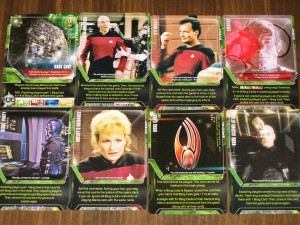
The Borg Invasion Scenario introduces events and ships that are unique to its scenario. Players can be eliminated if they end up with five Borg cards in their hand, so teamwork is essential to winning this beast of a scenario.
Setup
1. Each player starts with the same ten cards, forming their starting deck.
2. Players will seed the Space Deck. The Space Deck is a combination of the fifteen standard starship cards and whichever cards are appropriate from the scenario that you’ve chosen to play. If playing the Exploration Scenario, for example, you’d combine the fifteen standard starship cards and the twenty-five event and mission cards from the Exploration Scenario deck.
3. All Starbase Cards are shuffled and then nine are drawn in a 3×3 grid. This will be the available pool in which players can “purchase” characters, manuevers, and setups from.
4. The Basic Character Cards are sorted and placed near the Starbase Cards.
5. Each person receives a hit counter die, the starting value equal to their starter ship’s Defense value.
6. All players draw five cards from their deck.
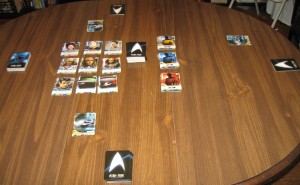
I forgot the dice in this picture, but here is your average setup. The Starbase cards are in the middle and the Space Deck is on the left.
Gameplay
I’ll only touch briefly on this, mainly because each scenario has its own unique set of rules regarding what players can do on their turn. To sum it up, a player can play cards from their hand and put them on their Bridge (temporary play area for that turn) and use said cards to purchase (using XP points) new Starbase Cards, repair damage to their ship, and perform more than one standard search and explore action. Search allows players to discard a Starbase card and draw a new one, whereas Explore allows players to draw the top card from the current scenario’s Space Deck. Once the player is finished with their turn, ALL of the cards they just played and acquired are then placed in their discard pile, and five new cards are drawn. Eventually, they’ll run out of cards and use their deck again, this time with the new cards they acquired previously.
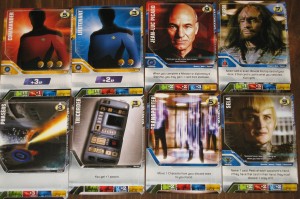
Basic Characters, Starter Cards, and Starbase Cards will all help players reach their scenario objectives, among other things.
Again, some scenarios (like the Borg Invasion Scenario) throw a wrench into the normalcy…for example, players MUST Explore from the Space Deck at the start of their turn as opposed to it being an option in the Exploration Scenario.
Players will encounter ships when Exploring the Space Deck. Using diplomacy, they may be able to take over the ship and use that new one as their flagship. A player can only have one active ship at a time. The old ship is placed in the player’s score pile. There are also instances where players will need to battle other ships and each other, comparing stats to see who inflects what damage first.
That is just a brief summary of the rules. Please be advised that as of the time of writing, I had issues accessing the online rulebook. If it is an issue on Bandai’s end, I hope they resolve it soon.
The Review
I was a bit overwhelmed at first by all of the cards. I had to read through the rulebook quite a few times, and even visit Bandai’s forums for some rule explanations that were left out of the manual. For example, when more than two players are in combat, the player CHOOSES which other player they want to attack. This tiny sentence was left out of the rulebook and I was left scratching my head as to how damage was assigned. In my opinion, the rulebook can use a little more work. As for the cards themselves, they keep with the theme well. I “knew” that I was playing a Star Trek game and as a die-hard Trek fan, I recognized all of the characters, manuevers, and etc.
Once the rules began to sink in, I felt a little better about the game in general and I wasn’t as intimidated. Still, expect to spend a few hours reading and deciphering the cards on your first few playthrus. With any new set of cards in games like this comes a learning curve. I recommend that new players start with the Exploration Scenario. I know, I know…you want…NEED…to fight the Borg…but the Borg Invasion Scenario is very challenging, especially if there aren’t many players. House rules may be required to give players a handicap in that particular scenario as the manual suggests none. When the kids and I cooperatively battled the Borg, I allowed all players to draw seven cards as opposed to five for their hand…just to keep things casual.
The kids, who are not as heavily invested into Star Trek as I am, thought that the game was a lot of fun. Both Anthony and Vinnie have experience playing Dominion, so understanding how the deck worked and how it recycled itself didn’t require much explanation. They were able to jump right in, buy out Starbase cards, and expand their decks quickly. They proved in short order that you didn’t have to be a Trek fan to appreciate this game, though if the subject comes up, you may want to explain to your eleven year old the difference between a photon torpedo and a photon potato. The more I think about it, the more epic a photon potato becomes. Note to self, write a letter to Rick Berman…”Dear Mister Berman, more photon potatoes please. Best Regards, Dad’s Gaming Addiction.”
Overall, I highly recommend this game. While you don’t have to be a Star Trek fan to enjoy the game, it certainly doesn’t hurt. Be advised that your first few playthrus may take you well into two or three hours, especially if you are in no hurry to explore the space deck. (Unless you are playing the Borg Scenerio…in that case, a bottle of Saurian Brandy may be in order.)
Final Verdict: 8/10

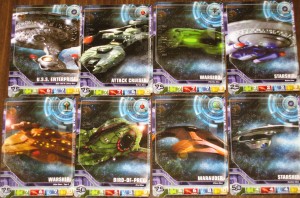
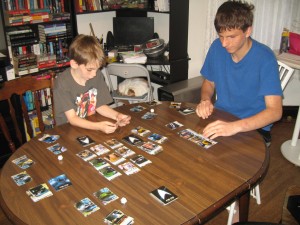
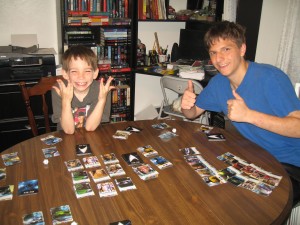
Hi,
I recently played Star Trek: TNG DBG, and would love to find one similar for my non-Trekkie friends to play (so far they are adverse to trying this one–even though I know they’d enjoy it!). Are there other games out there that feature scenario decks and cooperative play? I like the Star Trek game because of the scenarios/exploration deck, having different abilities to start out with (i.e. flagships), and then getting new abilities/characters every turn.
I’ve seen games like Pandemic and Thunderstone, but they don’t seem to provide the encountering new missions/scenarios aspect like Star Trek:DBG does.
Thank you!
Hi Faith!
Sadly, the only thing that is similar in my collection (that I haven’t reviewed yet) is Star Trek: The Next Generation Customizable Card Game, but that was released way back in the day. It’s similar to other customizable card games in that you buy expansion packs and the like, but you can do missions, assign personell to ships, and more. I don’t know if the game is still around, but it was a lot of fun when I played it in the 90s.
Star Trek Fleet Captains can be cooperative (2 vs 2), but it’s not a deck building game. It’s a Feds vs Klingons game, but you’ll have plenty of missions and other things to do.
Star Trek Expeditions is co-op…though it’s not a card game. Each player takes on the role of an officer and you work together to complete missions on a planet while staving off the klingon ship in orbit.
There’s also a number of expansions coming out for this particular Star Trek game…some sound very interesting! http://www.bandai.com/startrek/
Non-trek related for your friends…well you mentioned Pandemic, which is pretty fun…though you are right in that there isn’t a deck building mechanic. Pandemic, Flash Point Fire Rescue, Castle Panic…all good, but don’t have a deck building mechanic.
I did some research and came across these, but never played them so I can’t vouch for them:
http://boardgamegeek.com/boardgame/79073/resident-evil-deck-building-game
http://boardgamegeek.com/boardgame/77423/the-lord-of-the-rings-the-card-game
http://boardgamegeek.com/boardgame/94362/rune-age
http://boardgamegeek.com/boardgame/76247/eaten-by-zombies
http://boardgamegeek.com/boardgame/112092/shadowrift
Sorry that I couldn’t be more help, but I’ll keep an eye out and report back if I see anything you are looking for.